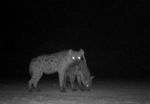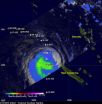(Press-News.org) In the southern Rift Valley of Kenya, the Maasai people, their livestock and a range of carnivores, including striped hyenas, spotted hyenas, lions and bat-eared foxes, are coexisting fairly happily according to a team of coupled human and natural systems researchers.
"I wouldn't call the results surprising," said Meredith Evans Wagner, a visiting scholar from the University of Florida in the Center for Systems Integration and Sustainability (CSIS) at Michigan State University and part of the research team. "Other research has shown that people and carnivores can coexist, but there is a large body of thought that believes carnivores need their own protected space to survive."
The paper "Occupancy patterns and niche partitioning within a diverse carnivore community exposed to anthropogenic pressures" was recently published in Biological Conservation. Other authors are Paul Schuette and Scott Creel, of Montana State University, and Aaron Wagner, postdoctoral researcher in the BEACON Center for the Study of Evolution in Action at Michigan State.
The paper's findings echo results of a study published in PNAS in September 2012 by Jianguo "Jack" Liu and Neil Carter of CSIS: namely that tigers and people are sharing the same space in Chitwan National Park in Nepal, albeit at different times.
Wagner and her colleagues spent just over two years documenting the carnivores of the southern Rift Valley, using motion-detecting camera traps to captures images of the creatures and people using four different areas of land: a conservation area with no human settlements, a grazing area that also had no human settlements, a permanent settlement area, and a buffer zone between the grazing and conservation areas that included seasonal human settlements.
While most of the results were expected -- the majority of carnivore photos were taken after dark, most of the larger predators, such as lions and spotted hyenas, tended to be found in the conservation area that didn't include any human settlements -- there were some intriguing results.
"We found that while there were more striped hyenas in the conservation area, there were also striped hyenas in the buffer zone, close to the human settlement area," Wagner explained. "The hyenas weren't avoiding that area; they were using the settlement area as a resource in addition to hunting."
When the Maasai slaughtered an animal for food, they throw the scraps out their back doors, which are at the edge of the buffer zone, where the striped hyenas were happy to eat them.
"Carnivores aren't a problem for this group of Maasai," Wagner said. "They've made a conscious decision to not hunt carnivores. If one of their livestock is killed by a carnivore, people don't go out and kill a carnivore in retaliation. It's a little bit unusual in that way. But in our study, we found that carnivores killing livestock didn't happen a lot."
"Wildlife is clearly driven away from the permanent settlement areas," said Aaron Wagner. "But the seasonal human migration out of the buffer zone keeps that area viable for wildlife. Numbers drop when the cattle and people move in, but the striped hyenas seem to have habits that allow them to compensate. They do scavenge around bomas [Maasai settlements] when the pickings are good, but they hunt, too. Even with the people around, there are enough prey left, or enough trickling in from the conservation area, that they have plenty to hunt. More often than not, when following a striped hyena that's foraging (or playing at a den) at 3 a.m., there's no indication that people are so close."
INFORMATION:
The research was funded by the National Science Foundation, the Cincinnati Zoo and the Panthera Corporation.
Carnivores, livestock and people manage to share same space study finds
2013-03-14
ELSE PRESS RELEASES FROM THIS DATE:
Bursts of star formation in the early universe
2013-03-14
PASADENA, Calif.—Galaxies have been experiencing vigorous bursts of star formation from much earlier in cosmic history than previously thought, according to new observations by a Caltech-led team.
These so-called starburst galaxies produce stars at a prodigious rate—creating the equivalent of a thousand new suns per year. Now the astronomers have found starbursts that were churning out stars when the universe was just a billion years old. Previously, astronomers didn't know whether galaxies could form stars at such high rates so early in time.
The discovery enables ...
1 in 4 colonoscopies in Medicare patients found to be potentially inappropriate
2013-03-14
Colonoscopy is one of the most effective cancer screening procedures available. Colon cancer grows very slowly and can be treated if caught early through screening. But, perhaps because of this success, older Americans are undergoing screening colonoscopies despite recommendations against screening in adults aged 76 and older.
A new study by researchers at the University of Texas Medical Branch at Galveston published online today in JAMA Internal Medicine shows that one out of four colonoscopies paid for by Medicare is potentially inappropriate under current screening ...
More accurate, sensitive DNA test allows early identification of fungus causing WNS
2013-03-14
MADISON, Wis., March 13, 2013 – Even after researchers studying White Nose Syndrome (WNS) established that a fungus called Geomyces destructans is at the heart of the devastating disease, detecting it depended largely on finding dead or dying bats.
This month, the journal Mycologia will publish research by a team of U.S. Forest Service scientists and partners identifying additional species of Geomyces and describing development of a highly sensitive DNA-based technique for early identification of Geomyces destructans on bats as well as in soils and on cave walls.
"The ...
Symbols, such as traffic lights, on menus effective in educating diners
2013-03-14
CHAMPAIGN, Ill. — A little-noticed provision of the Affordable Care Act requires all chain restaurants and retail food establishments with 20 or more locations to list calorie counts on their menus. But according to research co-written by a University of Illinois agricultural economist, numeric calorie labels might not be the most effective way to influence patrons to select "healthier" (often interpreted as lower-calorie) items.
Brenna Ellison, a professor of agricultural and consumer economics, says placing a symbolic label in addition to the numeric calorie information ...
NASA sees large decrease in Cyclone Sandra's rainfall intensity
2013-03-14
NASA's Tropical Rainfall Measuring Mission satellite, also known as TRMM, flew over Cyclone Sandra twice in one day and noticed a large decrease in rainfall intensity over a nine hour period.
On March 11, 2013, NASA's TRMM satellite twice flew above weakening tropical cyclone Sandra as it was passing to the west of New Caledonia in the southern Pacific Ocean. TRMM's Precipitation Radar (PR) had a very good view of Sandra as it passed directly above the tropical cyclone on March 11 at 1312 UTC (9:12 a.m. EST). TRMM PR measured rainfall at the extreme rate of over 206 mm ...
Dwelling on stressful events can increase inflammation in the body, study finds
2013-03-14
ATHENS, Ohio (March 13, 2013)—Dwelling on negative events can increase levels of inflammation in the body, a new Ohio University study finds.
Researchers discovered that when study participants were asked to ruminate on a stressful incident, their levels of C-reactive protein, a marker of tissue inflammation, rose. The study is the first time to directly measure this effect in the body.
"Much of the past work has looked at this in non-experimental designs. Researchers have asked people to report their tendency to ruminate, and then looked to see if it connected to physiological ...
Scientists discover novel chemical that controls cell behavior
2013-03-14
March 12, 2013 — Albuquerque, NM (UNM Cancer Center) — It's the spread of the original cancer tumor that kills most people. That's why cancer researchers vigorously search for drugs that can prevent metastases, the spread of cancer. The research team co-led by Angela Wandinger-Ness, PhD, and Larry Sklar, PhD, at the University of New Mexico Cancer Center has found a chemical compound that appears to control cell migration and adhesion, two important characteristics of metastatic cancer cells. The team recently published a paper describing how the first-in-class compound ...
Sun spits out 2 CMEs
2013-03-14
The sun recently erupted with two coronal mass ejections (CMEs). One began at 8:36 p.m. EDT on March 12, 2013 and is directed toward three NASA spacecraft, Spitzer, Kepler and Epoxi. There is, however, no particle radiation associated with this event, which is what would normally concern operators of interplanetary spacecraft since the particles can trip computer electronics on board. A second CME began at 6:54 a.m. EDT on March 13, 2013 and its flank may pass by Earth at a speed that does not typically have a significant impact at Earth.
Experimental NASA research models, ...
Vitamin D may lower blood pressure in African-Americans
2013-03-14
Boston – High blood pressure, a risk factor for heart attacks, heart failure and stroke, is 40 percent more common in African-Americans than in other American ethnic groups. In a new study from Brigham and Women's Hospital (BWH), along with the Dana-Farber Cancer Institute and Massachusetts General Hospital, researchers show that vitamin D supplementation may help African-Americans lower their blood pressure. The study publishes online in the March 13, 2013 edition of the American Heart Association journal Hypertension.
"This study may explain and help treat an important ...
US lifespans lags other high-income countries, tied to mortality rates under age 50
2013-03-14
Higher mortality rates among Americans younger than 50 are responsible for much of why life expectancy is lower in the United States than most of the world's most developed nations.
The research, by Jessica Ho, a University of Pennsylvania doctoral candidate in demography and sociology, found that excess mortality among Americans younger than 50 accounted for two-thirds of the gap in life expectancy at birth between American males and their counterparts and two-fifths between females and their counterparts in the comparison countries.
The study, "Mortality Under Age ...




